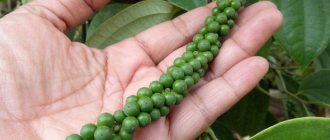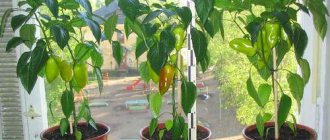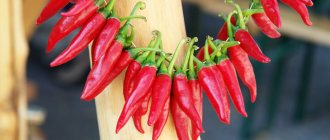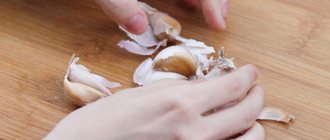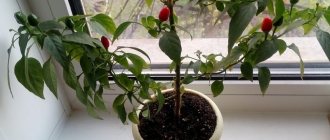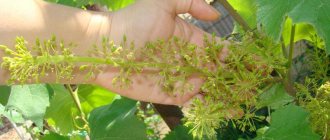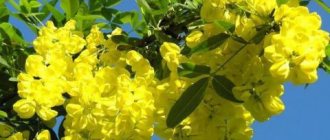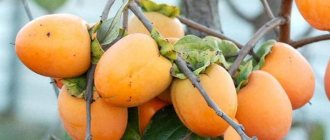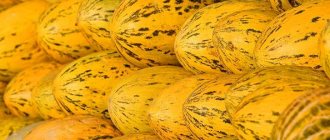How and where do black peppercorns grow?
The homeland of black pepper is India. But today this plant can no longer be found in the wild. It is grown exclusively for sale. Vietnam is a country where black pepper grows on huge plantations.
How does black pepper grow, on a bush or tree? An interesting question for many. In fact, it is a liana and it can grow up to 15 meters, has hard, sharp leaves and clings to any surface with its aerial roots.
The inflorescences look like clusters, similar to red currant tassels, only longer. The fruits are small round drupes that are initially green in color and turn red as they ripen.
For reference! You can count about 30 peas on one fruit. They turn black as they dry. The plant can bear fruit for up to 25 years.
How black peppercorns grow
Chemical composition of Malabar berries
Piper nigrum berries serve as a source of fats, proteins, carbohydrates, fiber, minerals, vitamins, resins, essential oils, alkaloids and many other phytocomponents. Among the unique ones are piperine and piperidine, which are responsible for the pungent taste of the fruit. But most of all the fruits contain starch - in some berries its amount reaches 60% of the total composition. The vitamin and mineral profile is represented by vitamins A, and, phosphorus, iron, calcium. Interestingly, 100 g of peppercorns contains three times more ascorbic acid than ripe oranges. But given the micro portions of the spice used, it is understandable that it is difficult to consider it as the main source of the vitamin. About a tenth of the chemical composition of black pepper is piperine, the component that actually makes the berries a hot spice. The effect of piperine is also enhanced by other “burning” components: chevisin, piperitine and piperidine, but there are very few of them in this product.
How to grow black pepper at home
In order for the pepper to sprout, grow and bear fruit, you need to create tropical conditions for it. Sunlight, heat and humidity are necessary for the life of the future spice.
It needs to be planted in small pots. It is important to foresee in advance how the vine will grow. She needs to climb up and weave along the support. The best option is a window, but it is important that the glass is not cold and protects from direct sunlight.
Home grown peppers
Where to get seeds
Seeds are rarely found in agricultural stores that sell garden crops. But for planting, you can buy a regular packet of spices at the grocery store. You need to choose high-quality planting material based on color and size.
The largest and darkest peas will produce good seedlings. The next stage of selection is soaking. Selected peas are soaked in warm water (not lower than +24 °C) for a day. Those that float up are removed, as they will not rise. Those that have fallen to the bottom and increased in size are suitable for planting.
It is important to know! It is important to buy only black peppercorns. Red and white peppers are not suitable for propagation.
The last stage of seed preparation is processing them in a growth stimulator. According to the instructions, the seed is soaked in a solution of Epin, Bud or Ovary.
How to sow correctly
The optimal time for sowing seeds is spring. Use one common container or individual pots. They are filled with river sand, which must be calcined and washed in advance. Place gauze soaked in warm water on top of the sand. The seed is placed on gauze and covered with another layer.
What is the best container to store in?
Fruits must be well prepared for long-term storage:
- It is necessary to use dense vegetables without stains on the surface;
- The tail of the pepper should be firm and green;
- vegetables should be well dried.
For storage it is better to use wooden boxes with a capacity of about 10 kg:
- the empty container is covered with paper or sawdust;
- Peppers are placed on top in a row;
- vegetables are covered on top with paper or sawdust;
- In the same way, 2 or 3 additional layers are laid out;
- All boxes are stacked.
Provide air circulation in wooden boxes. To do this, you can pre-drill small holes in the drawers. The storage should be dark, without sunlight.
Instead of wooden boxes, you can use wicker baskets. Vegetables are also divided into layers separated by sheets of paper. Air access to the fruit is through holes on the sides of the basket.
An excellent storage option is to use thick plastic bags with a load capacity of up to 10 kg. Completely dried fruits must be placed in open bags in an upright position. Once packaged, the bag should be tied tightly and there should be small holes on the sides of the bag to allow air to enter. Place it in a dark place.
There are several easy ways to keep peppers fresh in your home:
- Packed in a plastic bag with holes for air access. The bag is placed in the vegetable compartment of the refrigerator. Thus, fruits can be stored for up to 4 weeks;
- Vegetables can be coated with vegetable oil before placing in the refrigerator. This method does not wrinkle the fruits and keeps them fresh for a long time;
- If the apartment has a glazed balcony, vegetables can be placed in wooden boxes with thick paper. Packaged fruits should be covered with sawdust on top. The workpieces should not be exposed to sunlight so that the boxes can be covered with a bag or other materials that allow air to pass through.
To increase the shelf life of pepper to 4 months, the following trick is possible:
- Each vegetable should be wrapped in a separate sheet of paper. This ensures that the fruits do not come into contact with each other and will not infect each other with possible diseases. One of the disadvantages of this method is that it is impossible to monitor the condition of vegetables, since constant unfolding of paper negatively affects their shelf life;
- in the case of a large number of forms, if it is impossible to wrap each fruit, thick paper at the bottom of the box is folded in two layers.
If you don’t have room for peppers in your apartment, you can freeze them. This method preserves all the beneficial properties and taste of the product.
Transfer
Liana grows quickly and rapidly, especially if living conditions are comfortable for it. The roots of the plant quickly fill the container of the pot. And after a year they demand more space. Therefore, every spring black pepper needs to be transplanted into a pot 2-3 cm larger in diameter.
To avoid damaging the thin and long roots of the plant, it is best to use the transshipment method.
After transplantation, the plant should be removed in the shade for several days. It is not advisable to water abundantly in the first weeks.
Watering the beds and loosening the rows
Proper irrigation of plants and reducing inter-row distances is good disease prevention and an indispensable condition for caring for pepperoni.
This also includes proper irrigation:
- The water temperature should be 20-27 degrees, no more and no less;
- Pepper is poured twice a day, early in the morning and after 19 hours;
- When watering, it is recommended to avoid getting moisture on the leaves and fruits;
- they simply pour pepper under the root;
- The average water consumption is 5-7 liters per shrub.
Do not allow the soil to get wet or flooded, as excess moisture can cause root rot or snails, pepperoni's main enemies.
What about relaxation? Firstly, to provide air access to the roots. Weakening also improves plant uptake of nutrients and moisture in the soil.
Row spacing is usually done several times during the summer, depending on soil conditions. This is especially important after prolonged rain or heavy single rain to avoid stagnation of moisture and rotting of plant roots.
Black pepper propagation
When producing black pepper, it is propagated by cuttings. Young shoots quickly take root in new pots and grow. At home, the easiest way to propagate is by dividing the bush.
During the next spring transplant, you should separate several shoots and carefully separate their roots, or, in extreme cases, cut them off with a sharp blade.
Young bushes are planted in the same substrate as for planting. After dividing the bush, it is important not to water the pepper so that the thin roots do not begin to rot. The first watering is after 7-10 days. It is advisable to add potassium permanganate or Epin to the water.
Beneficial features
The spice has a powerful antibacterial effect. Helps preserve food, which is why it is so popular in hot Asian countries.
Able to normalize the digestion process. Helps with colds. It is an excellent antioxidant and improves metabolism.
With a lot of beneficial properties, it should be remembered that pepper is contraindicated in inflammatory diseases of the gastrointestinal tract, and its excessive use can be harmful.
The program “About the Most Important Thing” will talk about black peppercorns:
Growing peppers at home is easy. A little patience and careful care will allow you to get a very interesting plant at home, not only useful, but also with excellent decorative properties.
Try it, you will definitely succeed.
Black pepper, also called Malabarian berry, is a tall plant that has many leaves, and the pepper itself appears in the form of small peas that change in color as they ripen. The exporting countries of this product are mainly: Brazil, Sri Lanka, Borneo, Java and Sumatra.
It is difficult to overestimate the role of this product in traditional cuisine, because without its presence it is impossible to imagine most folk dishes - marinades, all kinds of soups, sausages and frankfurters, fish and mushrooms. It is recommended to add pepper to the dish at the very end of cooking, otherwise the food will become too bitter.
It should be stored in an airtight bag or container, otherwise it will lose its taste and fragrant aroma. If possible, it is best to use fresh peas, as they have the same wonderful aroma and contain more benefits for the body.
You can also grow peppers at home or in the country, knowing some basics and little tricks, which we will try to talk about in this article.
Harvest and storage
A full harvest of black peas can be obtained already in the third to fifth year after planting. It all depends on the conditions of the plant.
After flowering, round knuckles begin to form on the tassels, which will become a spice in the future. At the very beginning they are green. As they ripen, their color turns yellow, then pink and red. It takes 6 to 8 months for the tassel to mature.
The harvest also does not take place in one day. The peculiarity of the plant is that the seeds on one tassel ripen at different times. It may take two months from the redness of the first to the last pea.
If you want to use the crop as a spice, the peas should be collected while they are still green. The collected peppercorns must be laid out on a cloth and dried in direct sunlight.
Important! It is necessary to dry until all the pulp is dry: the pepper turns into the usual hard black or brown pea.
It is necessary to store dried spices in a dark and dry place, here humidity will only be harmful. Airtight glass containers are an excellent option for preserving the freshness of dried peppers. But in order to retain all the aroma and taste, it is important to keep the peas whole and grind them directly during cooking.
Gradual ripening of peas
Botanical description
The scientific name of the plant from which black pepper is made is Piper Nigrum.
Did you know? Black pepper is the top selling spice
—
about 200,000 tons of this fragrant spice are sold annually around the globe.
It belongs to the pepper family (Piperaceae) and grows only in warm climates.
Botanical description of the plant:
- The length of the plant in the wild is up to 15 m. The roots are aerial and form at the nodes.
- The leaves are ovate, leathery. They are colored gray-green and can reach a length of 10 cm.
- The flowering period falls at the end of April or beginning of May. The plant blooms and bears fruit in the second year after planting.
- The inflorescences are shaped like long spikelets and consist of small white flowers. The length of the inflorescence is about 10 cm.
- The fruits are located on cobs that are up to 15 cm long. They are spherical drupes with a diameter of about 5 mm, covered with a dense, hard skin. One cob contains about 25 peas.
- The color of unripe fruits is green. After full ripening, the peas turn red. Their taste is hot.
- The plant bears fruit 2 times a year for up to 50 years.
The calorie content of black pepper is 255 kcal per 100 g.
Nutritional value of the product:
- proteins - 10.95 g;
- fats - 3.26 g;
- carbohydrates - 38.31 g.
Depending on their origin, there are several varieties of black pepper, which differ in the appearance of the fruit and taste characteristics:
- Malabar - grown on the Malabar coast, the fruits have a persistent aroma and large size, characterized by a pungent taste;
- Indonesian - grown in the province of Lampong on the island of Sumatra, the peas are medium in size and have a spicy taste, and their aroma is very strong;
- Brazilian - grows on the coast of the Amazon River in the state of Pará and looks unusual - the fruits are covered with a smooth, black peel, and their core is white;
- Chinese - grown in the southeastern part of the country, in Hainan province. The peas have a characteristic light skin, and their taste is milder than that of other pepper varieties;
- Malaysian - grown in Sarawak. The fruits do not have such a strong aroma as other varieties, but have a very pungent taste;
- Ceylon - grown on the island of Sri Lanka and has a strong scorching pungency;
- Vietnamese - grown in Vietnam and distinguished by the large size of its fruits, which are gray, black or brown in color. The peas do not have a strong aroma, but have a burning taste.
Unacceptable mistakes during care
The tropical resident on the window will actively respond to any failures in the care regime. It is important to monitor these signals promptly and know how to eliminate them. The most common mistakes in growing black pepper:
- Lack of light. The liana may stop in its active growth, this is especially noticeable in the spring. With a lack of sun, the stems often stretch out, becoming thin, new leaves appear less frequently and the distance between them increases. With a prolonged lack of lighting, the plant may begin to shed its leaves.
- Lack of nutrition. All the signs that are described for a lack of light also have something in common with another reason - the depletion of the earthen lump in the pot. Also, to the above problems, another one may be added - yellowing of the tips of the leaf or the entire leaf plate. Peppers need regular fertilizing and annual soil changes.
- Lack of moisture. Rare watering or drying out of the soil in the pot will cause drying or darkening of the edges of the leaf plates. Often there is not enough moisture not only in the soil, but also in the air. It is necessary to restore the irrigation regime along with spraying.
- Excess moisture. Despite the need for abundant moisture, moisture can stagnate at the roots of the vine. This will be visible on the leaves of the plant - they will become yellow and drooping. The reason for this may be not only excess and frequency of watering, but also a poor drainage system or a pot that is too large after the next transplant.
- Sunburn. Direct rays of the sun leave brown or orange circles on the glossy leaves of the pepper vine. These areas will soon dry out and crack, ruining the appearance.
A feature of many varieties of black pepper is the appearance of white round growths on the back of the leaf. This is simply a varietal characteristic of the plant, and is not a cause for concern at all. There is no point in removing such “warts”; they are part of the leaf blade.
Only southerners can grow black pepper in their country house or garden, and only for one year. But it is quite possible to plant exotic plants in your window as an ornamental plant. With proper care, the pepper will definitely bloom and bear spicy fruits that will be much more aromatic than store-bought black peppercorns.
Caring for the first shoot
As soon as a sprout appears, you need to remove the cover from the pot and provide the following care:
- The pot should be in a shaded but not dark place, without direct sunlight.
- The air temperature in the room is still controlled - at least 25C in summer and 18C in the cold season. If the temperature drops below 10C, the pepper will disappear.
- The plant should be provided with abundant watering in spring and summer. In autumn, less water is required, and in winter you need to water only when necessary. For good crop growth and health, you need to spray it with water from above.
- In indoor conditions, the plant, of course, will not grow 15 meters long, but it can easily reach 2 meters. Therefore, you need to prepare a support for the vine.
- When the second leaf appears on the plant, you need to feed it. Chicken manure diluted in water or a mineral complex for decorative deciduous crops are suitable for this. There is no need to feed the plant in winter and autumn, but once a week in summer and spring.
If you follow the rules for growing black pepper and proper care, the plant will bloom and begin to bear fruit in the second year of its life.
How to fertilize bell peppers
Experienced gardeners say that the best option for feeding peppers is active mulching with freshly cut grass. Moreover, the thicker the layer of mulch, the better. And then the inhabitants of the soil will do everything for you. By recycling the mulch, they will feed the soil with the organic matter your garden needs.
It is not the plant itself that needs to be watered, but the grass laid out in a layer on top of the soil. There is one rule for mulching: you cannot dig up the soil along with the mulch, otherwise putrefactive processes will begin to form, which will lead to pepper diseases. The mulch should remain on the surface of the bed until the end of the season. More details in the next video.
